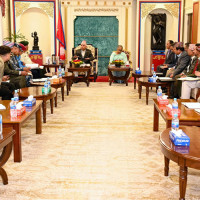- Sunday, 19 October 2025
75 years’ fruitless enterprise for self-reliance in sugar
Kathmandu, June 26: Believe it or not, 50 per cent of sugar consumed in an agrarian country like Nepal is imported. Although the Morang Sugar Mills Limited, the first sugar mill in Nepal, was established in 1947, which led to commercial sugarcane cultivation, Nepal still heavily depends on imports to meet sugar demand.
Yes, once in 2003, Nepal exported raw sugar to EU countries under the Everything but Arms (EBA) trade preference. This means Nepal had become self-reliant in sugar. But today, the situation is otherwise. Sugar shortage often haunts the Nepalis during festival seasons.
Policy flaws and corrupt practices of those who reached in power or influenced power are blamed for this reverse journey of Nepal’s sugar production. Otherwise, Nepal should have been self-reliant in sugar for ever in 75 years after the first sugar mill came into operation in the country. When the politicians and traders make more money in the form of commission from the import of sugar, they tend to discourage local products, which has happened in Nepal over the years. This is evident from the fact that Nepal had exported sugar to EU countries in 2003.
In 75 years after the establishment of first sugar mill in Nepal, the number of sugar mills has spread to 12 districts. But at the same time, the sugarcane cultivation area has diminished as the farmers started removing cane plants for failing to get payment from the mills. The poor farmers had to walk to Kathmandu to exert pressure on the government to get the price of their produce. Many people have not forgotten the plights of the sugarcane farmers who travlled all along from Madhes to Kathmandu to demonstrate at Maitighar Mandala braving the biting cold of winter three years ago, when one of the demonstrators perished.
Although the mills started paying the farmers after the Kathmandu march of the sugarcane farmers, still many farmers have not received the dues from the sugar mills, and this has discouraged them to continue with cane cultivation.
According to the statistics of the Ministry of Agriculture and Livestock Development (MoALD), sugarcane production and cultivation area has been declining over the years.
The production of sugarcane which was 3.558 million tonnes in the fiscal year 2017/18 has come down to 3.159 million tonnes in 2021/22.
Similarly, the area of cultivation has also decreased to 62,567 hectares in 2021/22 from 78,609 hectares of land in 2017/18.
About 3.557 million tonnes of sugarcane was produced in 71,624 hectares in the fiscal year 2018/19, 3.400 million tonnes in 68,565 hectares in 2019/20 and 3.183 million tonnes of sugarcane in 64,354 hectares in 2020/21.
Due to the agitation of sugarcane farmers and the efforts of the government, the arrears of sugarcane mills for the last 4-5 years have now been almost recovered. However, some sugarcane mills are yet to pay farmers dues, said Kapil Muni Mainali, president of Federation of Sugarcane Producers of Nepal.
Around a dozen sugar mills in the country produce around 130,000 tonnes of sugar annually whereas Nepal’s annual sugar consumption stands at around 260,000 tonnes. Until a decade ago, Nepal used to produce as much as 230,000 tonnes of sugar annually, which was enough to meet the local consumption.
With declining sugarcane production, the number of sugar mills has also declined. So far out of the 31 mills in existence, only 10 are in operation at present.
With high dependence on imported sugar, the price of sugar has also soared in the local market over the three weeks after India imposed a ban on the export of sugar effective from June 1 to balance the price of sugar after its price soared in India. Most of the imported sugar in Nepal comes from India.
India’s ban on sugar export will affect the supply chain in Nepal, resulting in price hike and black marketing.
The price of sugar has gone up by Rs. 15 per kg in Nepal in the last three weeks after India imposed the ban, said Amul Kaji Tuladhar, general secretary at the Nepal Retailer Association.
He said that the sugar price in the market has been gradually increasing since the Indian government banned sugar export.
According to him, until three weeks ago, retailers were selling sugar at Rs. 95 per kg. At that time, the industrialists were supplying sugar to retailers at Rs. 88 per kg.
He said that even though there is enough sugar in the market, the price is still rising.
“There is no problem in sugar distribution. However, retailers are compelled to sell sugar at Rs. 105 to Rs. 110 per kg after its price has been increased by the wholesalers,” he said.
“Black market has started in the name of India’s ban. The wholesalers have increased the price of sugar in stock, which is unnatural,” he told The Rising Nepal.
Normally, the price of sugar used to increase artificially in the market for four months from Shrawan to Kartik when stock of local production gets diminished. Its price starts falling from Mangsir after cane crushing time begins.
But this year, the price of sugar increased in the local market from the month of Jestha, citing the price hikes in the international market.
President of the Consumer Rights Investigation Forum Madhav Timalsina claimed that black marketing activities are growing due to the protection of black marketers by the government itself.
“Traders are raising the price of sugar in stock after the Indian government imposed a ban on sugar export, which is illegal. Sugar has not been imported after the Indian ban,” he said.
Heavily depends on imports
Urmila KC, vice spokesperson of the Ministry of Industry, Commerce and Supplies, said the country has to import about 50 per cent of sugar of local demand annually.
“It is estimated that about 250,000 to 280,000 tonnes of sugar is consumed annually in the country. But only around 130,000 tonnes of sugar is being produced,” she said.
According to the Sugar Producers’ Association, they have about 30,000 tonnes of sugar in stock at present, she said. About 131,000 tonnes of sugar was produced in Nepal this fiscal year.
She said that the government was aware about the present situation of price hikes of sugar and running out the stock of locally produced sugar in the sugar mills. She said they have started discussion to import sugar from abroad to meet the local demand.
“India has banned the export of domestically produced sugar. However, traders can export a certain per cent of imported sugar to other countries. So, we can import sugar from the traders of India,” she said.
It is certain that the price of sugar would increase further during Dashain and Tihar festival if the government failed to import enough sugar to meet local demand, especially for Dashain, Tihar and Chhat festivals when more than 30,000 tonnes sugar is consumed.
According to the trade statistics of the Department of Customs, sugar worth Rs. 5.38 billion has been imported during the first 11 months of the current fiscal year 2021/22. Sugar worth Rs. 10.19 billion was imported in the fiscal year 2020/21, Rs. 2.46 billion in 2019/20, Rs. 0.93 billion in 2018/19 and Rs. 11.65 billion in the fiscal year 2017/18.
STC stops selling sugar
Brajesh Kumar Jha, Divisional Manager, Salt Trading Corporation, informed that STC does not have any sugar for sale at present.
“For the past three weeks, we have stopped selling sugar directly to consumers from the STC shops,” he said. After the stock dropped, STC stopped selling sugar to wholesalers about a year ago,” he said. The STC was selling sugar 2 kg per person at Rs. 79 per kg until three weeks ago.
Although the Ministry of Industry, Commerce and Supplies proposed a year ago to allow STC to import sugar, the government has not yet allowed the STC to purchase additional sugar.
The spokesperson of MoICS KC said, “The STC has been selling sugar to retailers, keeping its presence in the market for three weeks from the sugar it imported two years ago. But, now the stock of sugar with STC had finished and the government has not given us permission to import sugar in the customs subsidy,”
The STC had imported around 20,000 tonnes of sugar two years ago as per the government permission of July 26, 2020.
She said that a proposal was sent for the import of 50,000 tonnes of sugar on August 24, 2021 but no response was received from the Finance Ministry till Tuesday. According to the STC, it has just issued two global tenders for the import of 15,000 tonnes and 5,000 tonnes of sugar as per the direction of the Ministry of Industry, Commerce and Supplies.
Similarly, it has also issued domestic bidding for the purchase of 5,000 tonnes of locally produced sugar for the second time after no one participated in the first bidding. Farmers shifting from sugarcane farming
The production of sugarcane could not increase in line with the demand as many sugarcane farmers turned towards other crops after they were unable to receive dues from sugar industries in time.
The bitter relationships between farmers and sugar producers, the random process of determining sugarcane price and delayed payment for sugarcane by sugar mills are the major reasons behind the decrease in sugarcane cultivation, Mainali said.
He said that the farmers have taken to other crops, including maize, paddy and others instead of sugarcane because they could not recover their cost of production from the price fixed by the government.
He said that the government’s goal of becoming self-reliant in sugar would not be achieved by disappointing the farmers.




-square-thumb.jpg)

-original-thumb.jpg)









